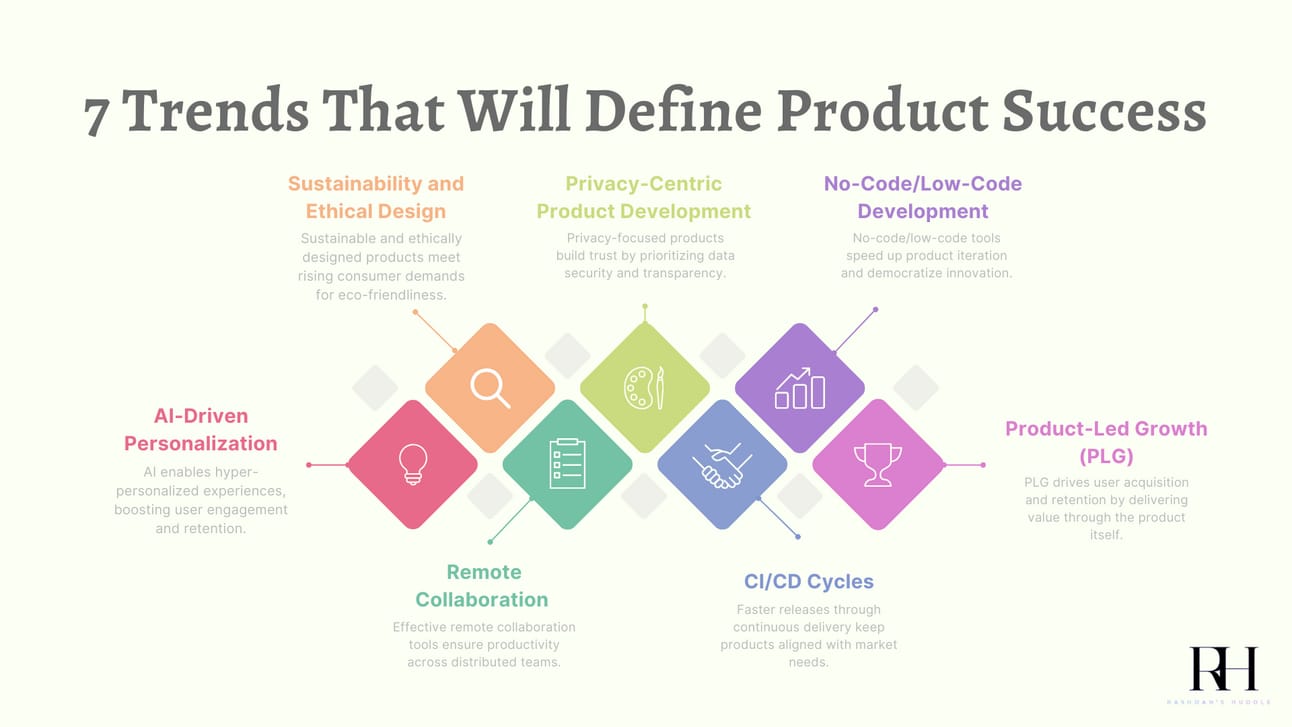- Rashdan's Huddle
- Posts
- The Future of Product: 7 Trends That Will Define Success
The Future of Product: 7 Trends That Will Define Success
7 Trends Driving Product Success

Hey product folks,
“In a world where product development cycles are shrinking, and consumer expectations are constantly changing, the future belongs to those who can adapt.”
New technologies, customer expectations, and market demands mean that what worked five years ago might not work today—and certainly won’t work five years from now. As product managers, it’s critical to stay ahead of these changes and be ready to pivot when necessary. In this edition, we’ll dive into:
The foundation of product success
7 major trends that will define the future of product development
Common mistakes we should avoid
The Foundation of Product Success
Before diving into the trends, let's revisit the fundamental principles that underpin successful product development:
Customer-centricity: Always put the customer at the center of your product strategy. Understand their needs, pain points, and desires.
Problem-solving: Build products that solve real problems and deliver value to your target market.
Innovation: Continuously seek out new ideas and opportunities to differentiate your product.
Adaptability: Be prepared to pivot and adjust your product strategy as market conditions change.

7 Trends That Will Define Product Success
7 Trends That Will Define Product Success
AI-Driven Personalization: AI isn't just hype anymore – it's the backbone of next-gen personalization. Spotify's Discover Weekly and Netflix's recommendation engine are just the beginning. The products that win will use AI to create experiences that feel magically customized to each user.
Sustainability and Ethical Design: Users increasingly vote with their wallets for products that align with their values. Whether it's Patagonia's Worn Wear program or Fairphone's modular design, sustainable and ethical products are becoming a competitive advantage, not just a nice-to-have.
Privacy-Centric Product Development: With regulations like GDPR and CCPA, privacy isn't just a legal requirement – it's a product feature. Successful products will bake privacy into their core, using techniques like data minimization and privacy by design to build user trust.
No-Code/Low-Code Development: The democratization of product creation is already here. Platforms like Webflow and Airtable are empowering non-technical users to build complex products. This trend will redefine how we think about development cycles and cross-functional collaboration.
Product-Led Growth (PLG): The PLG model is gaining traction. Products that drive acquisition, retention, and expansion directly through usage—without relying on heavy sales tactics will dominate. This trend is particularly relevant in SaaS, where user experience is the product.
Continuous Delivery and Shorter Development Cycles: Speed is everything. With CI/CD pipelines becoming more sophisticated, product teams can deploy updates more frequently and with greater confidence. The future will demand quicker iterations and faster shipping without sacrificing quality.
Remote Collaboration and Distributed Teams: Remote work isn’t going away. If anything, it’s becoming the default. Product teams must adapt by building seamless collaboration environments that facilitate distributed teams to work efficiently. Tools like Slack, Figma, and Notion are just the beginning.
Common Mistakes to Avoid
As we chase these trends, let's not forget the basics:
Don't add features just because they're trendy. Always tie back to user needs and business goals.
Avoid over-complicating your product. Sometimes, the simplest solution is the best.
Don't neglect your core offering while pursuing shiny new capabilities.
Resource
The future of the product is exciting, but it can also be overwhelming. Remember, you don't need to adopt every trend at once. Start by identifying which of these align best with your product strategy and user needs. Then, experiment, learn, and iterate.
The products that will define the next decade aren't just technically impressive – they're thoughtfully designed, ethically built, and deeply attuned to user needs. As PMs, we have the privilege (and challenge) of bringing these products to life.
If you enjoyed this edition of Rashdan's Huddle, make sure to subscribe for more insights straight to your inbox. Your support keeps us growing and delivering valuable content to product enthusiasts like you!
Until next time, keep building awesome products.
What do you think of this post? |